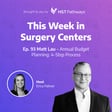Podcast Introduction
00:00:01
Speaker
Welcome to This Week in Surgery Centers. If you're in the ASC industry, then you're in the right place. Every week, we'll start the episode off by sharing an interesting conversation we had with our featured guests, and then we'll close the episode by recapping the latest news impacting surgery centers. We're excited to share with you what we have, so let's get started and see what the industry's been up to.
Guest Introduction: Hal Nelson
00:00:27
Speaker
Hi, everyone. Here's what you can expect on today's episode. Hal Nelson is the vice president of anesthesia services at MSN Healthcare Solutions. And he joins us this week to share five revenue optimization strategies for anesthesia providers. The tips and strategies that he shares are incredibly helpful so that anesthesiologists can make sure that they're collecting every dollar that they've earned.
00:00:52
Speaker
These tips are also really helpful for Surgery Center staff so that they can understand the role that they play as well.
Upcoming News Highlights
00:00:59
Speaker
In our news recap, we'll cover black boxes for the operating room, new prior authorization rules and changes, a major revamp of the current organ transplant system, and of course, end the new segment with a positive story about a nurse in Connecticut who's awarded the Magnet Nurse of the Year. Hope everyone enjoys the episode and here's what's going on this week in Surgery Centers.
Anesthesia Compliance & Revenue Management
00:01:28
Speaker
Hi Hal, welcome to the podcast. Thank you, Erica, happy to be here. Yeah, we're excited to have you. All right, tell us a little bit more about yourself, your healthcare experience and what you'd like our listeners to know.
00:01:42
Speaker
Sure, so my name is Hal Nelson. I'm the Vice President of Anesthesia Compliance for MSN Healthcare Solutions. My background is I started on the insurance side, worked for several national anesthesia, or excuse me, insurance companies from the late 80s to the early 90s, then I've been in billing.
00:02:06
Speaker
on the billing side, specifically with anesthesia since 1996. So I've worked with a lot of different practices, a lot of different models, and look forward to sharing my experience. Awesome. And tell us a little bit more about MSN Healthcare Solutions. What do you guys do?
00:02:26
Speaker
So my current employer, MSN Healthcare Solutions, we are a revenue cycle management or billing company. We have a suite of services above and beyond that, such as our own Qualified Clinical Data Registry or QCDR for MIPS reporting. We have a pre-collection, a patient AR pre-collection solution that we're
00:02:53
Speaker
excited about with the company that we partner with. And essentially, we are one of the only remaining privately held national anesthesia billing companies. Most of the others that are in this space are private equity backed. We are not the sole. The owners are the gentleman who founded the company.
00:03:18
Speaker
named Bo Trotter and a lot of the employees that were with MSN in 1996 when it started are actually owners as well. Awesome. Very, very nice company to work for. Yeah, that's great.
Anesthesia Provider Landscape
00:03:34
Speaker
That's great. We knew we wanted to do an episode that focused more on the anesthesia providers world because we do normally talk about surgery centers, but
00:03:44
Speaker
obviously they're intertwined and there's a lot that our listeners can learn from whether they work at a surgery center or are part of an anesthesia group. So we thought you would be the perfect guest to come on and share some tips on how anesthesia providers could optimize their revenue. To kick us off, can you share a little bit about what the landscape looks like right now in general for anesthesia providers?
00:04:11
Speaker
Sure. So right now, there's a staffing shortage, nationally speaking, as I think anyone watching this podcast will realize.
Shift to Ambulatory Settings
00:04:22
Speaker
It's hard to get anesthesia personnel because of a shortage in the marketplace that includes anesthesiologists, CRNAs, Anesthesiology Assistants, or AAs. So that's first and foremost, that's in the background. Also what's happening is
00:04:40
Speaker
Medicare had traditionally had a list of surgeries that would only be payable in inpatient settings. If you've been monitoring the landscape over the last couple of years, you've realized that Medicare has become a little more flexible on that. They have changed their, what they call their inpatient only list to allow for a lot of surgeries to be paid in ambulatory settings like ASCs.
00:05:09
Speaker
So we're seeing a migration of cases, especially orthopedic that are moving from hospital venues to ambulatory surgery centers. And so that creates more opportunity for ASC owners and investors that creates more opportunity for anesthesia practices that are looking to cover such locations. So we're seeing a higher volume bottom line
00:05:35
Speaker
of outpatient ambulatory cases compared to inpatient for certain types of surgeries. Gotcha. That makes sense.
Revenue Optimization Strategies
00:05:47
Speaker
And I think everyone can understand the staffing shortages that are going on across the board.
00:05:55
Speaker
That's interesting. Do you think that that COVID you said last couple of years, like did everything that happened with COVID kind of start pushing more cases in the inpatient world or you think, or sorry, outpatient world, or do you think we were going that route regardless?
00:06:11
Speaker
I think it has less to do with COVID and it has more to do with expense and efficiency. So if you look at, if you just look at dollars and cents, if you look at a particular surgery that's done in a hospital setting, the insurance companies get a, let's say it's an inpatient, let's say it's an outpatient surgery.
00:06:33
Speaker
So the insurance company gets a bill, a facility bill from the hospital. They get a professional bill from all of the entities that are involved in the case, surgeon, anesthesiologist, et cetera, sometimes pathologist. And I think on the facility bill side, if you compare the hospital outpatient perspective payment system, which is how
00:06:59
Speaker
Medicare, for example, pays outpatient hospitals and you compare that to the DRG Gruber rate, which is how Medicare pays ASCs.
00:07:13
Speaker
It's simply less expensive in many cases to do the same procedure in an ambulatory surgery center than it is an outpatient hospital. And then if you parlay that with the staffing shortages, you're usually in and out quicker in an ASC than you are in an outpatient hospital.
00:07:38
Speaker
So they're usually more, they're typically more efficient. It's less costly. And again, it's not suited for all surgeries, but low acuity, short duration cases, for example, eye cases, GI cases, now orthopedics are a good candidate for outpatient surgery centers, just to mention a few. Yeah, definitely. And you had mentioned,
00:08:08
Speaker
Do you find that anesthesiologists typically understand the billing process and how to make sure they're collecting every dollar that they've earned? Well, it's one thing that medical providers are not taught in medical school. They don't really study the nuances of billing, which is a completely different world.
00:08:39
Speaker
There's a lot of detail to it. And those of us that have been in it for a long time like to share what we know. But to answer your question, I would say that the majority of anesthesia personnel is really not that well versed on the billing requirements or charting requirements and how to optimize revenue for their products.
00:09:05
Speaker
Yeah, that seems to be the theme that we're seeing on our end as well. So that's why we're here today. We can give our listeners five real ways that anesthesia providers can start to optimize that revenue and really understand the billing process and start collecting every dollar and make sure they're not leaving anything on the table.
00:09:27
Speaker
So thank you for all that background, but let's let's jump into tip number one So I know you wanted to talk about patient ASA classification. So what what advice do you have for that one?
Billing Tips for Anesthesia
00:09:40
Speaker
So For those that are unfamiliar with this term the the patient's ASA status or classification is a
00:09:50
Speaker
is a labeling system that each anesthesia provider, whether it's an anesthesiologist or a CRNA, they're doing the pre-anesthesia assessment with the patient, and they're assigning them a risk category between one and five, five being the highest acuity, one being the lowest acuity.
00:10:13
Speaker
In surgery center settings, you're obviously not going to see the really sick patients. Those are going to be seen more in hospital venues. So for surgery centers, you'd expect to see ASA1, which is normal healthy patient, ASA2, which is mild systemic disease.
00:10:36
Speaker
ASA3, which is a little higher risk level. You wouldn't expect to see anything higher than an ASA1 through an ASA3. So these are rankings, so to speak, that the anesthesia provider gives the patient during the pre-anesthesia assessment, which is an interview prior to the surgery. Now, the significance of the ASA status is that
00:11:02
Speaker
Some insurance companies like the ones that I used to work with will actually pay higher for an ASA 3 or above. So ASA 1 and ASA 2, the very healthy patients, no additional payment. Once you get to an ASA 3, ASA 4, ASA 5, again, the only one that's going to pertain to surgery centers is typically an ASA 3.
00:11:26
Speaker
have the potential to receive additional reimbursement from insurance companies for ASA 3 or above. Now, that brings me to the issue of why is this even being talked about because
00:11:44
Speaker
If you were to survey 100 anesthesia professionals and ask them, this particular patient has the following underlying conditions prior to having surgery, what would you assess this patient as being, an ASA-2 or an ASA-3? And this has actually been confirmed through studies performed by the American Society of Anesthesiologists. It's very subjective in nature.
00:12:09
Speaker
So you could have one provider who's saying the patient's an ASA2, another provider saying the patient is an ASA3. So because there's revenue tied to this potentially with a particular case, you want to make sure that your practice and all of your providers are consistent in how they document ASA status for patients.
00:12:36
Speaker
It's, I'll give you the best, the best example on this, Erica, is patients who are, who are morbidly obese. So there's a patient has a BMI status. Obviously every patient based on their height and weight has a BMI score. BMI score of 40 or above.
00:12:57
Speaker
constitutes morbid obesity. That is automatically an ASA3. However, if you were to ask members of a practice, how do you classify morbidly obese patients? You'd probably have some that would say it's an ASA2, others that would say it's an ASA3. So because of that, you want to have consistency in your labeling of these patients in this scoring classification system and
00:13:27
Speaker
The best practice is to have an internal meeting with your group to go over common comorbidities or underlying conditions, decide as a group what you're going to call these, what you're going to classify these as, and use the ASA's tool that is free that lists examples of
00:13:51
Speaker
uh, conditions that fall into certain ASA categories. So bottom line is you want to just be consistent in your, in your application of these, of these modifiers, uh, for billing. And you want to make sure that everyone's charting the same way consistently. Okay. That makes sense. And we will definitely, um, put a link to what you had just suggested, um, that they can refer to in the episode notes. So everybody can have easy access to that.
00:14:21
Speaker
All right, let's go to tip number two. Tell us about anesthesia start and stop times. What revenue optimization tips are available there?
Charting for Accurate Billing
00:14:32
Speaker
So the thing to glean from this topic is that anesthesia start and stop time has a defined period defined by CMS Medicare, the AMA who writes the CPT book.
00:14:47
Speaker
It's all the same. There's no variance in what start and stop time is. So let's define those two points. Start time is defined as when the anesthesia provider begins preparing the patient for the induction of the anesthetic. And here's the key takeaway here, either in the operating room or the equivalent area.
00:15:12
Speaker
The equivalent area can be defined as the pre-op holding area in a surgery center. So let's say for a GI endoscopy patient, you are
00:15:26
Speaker
let's say you're sedating the patient in pre-op holding. And so you're giving some sedation and then you're moving that patient over to the surgical suite for their procedure. Time can start prior to entering the operating room or the surgical suite area. It can actually begin in pre-op holding as long as you have noted that you have administered sedation.
00:15:55
Speaker
and that you were continuously present with that patient. So where a lot of groups lose money, unfortunately, just not knowing what the obscure billing rules are is their start time will be OR entry time, and their stop time will be OR departure time. They're leaving, in some cases, they're leaving three, four, five minutes of pre-op time,
00:16:21
Speaker
three, four, five minutes of PACU time where they were actually physically present with the patient beyond just the operative suite number of minutes. And just in closing on that, so I talked about start time, what that is defined as, stop time is defined as,
00:16:42
Speaker
And the patient is stable and is turned over to recovery room personnel, which is typically outside of the OR again. So if you're limiting yourself to procedure room time only, you're probably leaving anywhere between five and 10 minutes of billable time on the table for each case, give or take. Yeah. I would imagine that would add up pretty quickly.
00:17:09
Speaker
One last comment real quick on the time issue. We've actually seen some facilities where the anesthesia providers understand what the rules are for start time, but it's a logistical problem because they can't actually hit the start button until they get to the procedural room.
00:17:30
Speaker
So in other words, they're not able in pre-op holding to hit a button that starts their anesthesia time and they have to wait until they enter the room. So that can be addressed through talking to your EMR vendor and just finding out how do we get the ability to actually hit that button and start time when we're actually beginning sedation in pre-op holding.
00:18:00
Speaker
Every minute adds up is the takeaway there. Yeah, I would imagine. Okay, that makes sense. All right, shifting to tip number three, charting procedural and diagnosis information. What's going on there?
00:18:16
Speaker
So as anesthesia claims go, your payment is directly tied to the complexity of the surgery that was performed. So your anesthesia reimbursement is based on what the surgeon did.
00:18:37
Speaker
charting accurately sometimes requires, if this information is not already captured through your electronic medical record or your Anastasia information management system, if the surgical specificity is not already being populated there by the surgeon or the surgical tech,
00:19:00
Speaker
It's important that you actually document everything that the surgeon did. Sometimes that requires asking the surgeon what they're billing for, what they're coding for at the end of the case.
00:19:12
Speaker
But I think the most important thing to know about this is you never wanted to chart the procedure based on the planned procedure. Because as we all know, the planned procedure can change midstream. So patients coming in for a certain procedure, the surgeon actually ends up doing something a little bit different.
00:19:38
Speaker
that needs to be documented to make sure that you are getting paid for the clinical work that you are doing as an anesthesiologist, for example, or a nurse anesthetist. Yeah, that definitely makes sense. Very important to document exactly what the surgeon did.
00:19:59
Speaker
There are a number of surgeries that depending upon what you write down, it impacts how you are paid. For example, someone's doing a near shoulder scope, very common ASC procedure, so arthroscopy. You write down the planned procedure, which is knee scope or shoulder scope, what actually ends up happening by the surgeon
00:20:22
Speaker
orthopedic surgeon is they end up doing a knee arthroscopy with a medial mastectomy or they end up doing a shoulder arthroscopy with a rotator cuff repair. By writing down that additional documentation, it yields an additional one to two units per case for your same anesthetic that's being provided just by providing greater granularity in the procedural description. Mm hmm. Yeah.
00:20:51
Speaker
And if you had to guess what percentage of cases vary versus what's planned versus what actually takes place.
00:21:01
Speaker
In a surgery center setting, I would say that what's written down on the board for what the room is being booked for, how often that actually changes is probably not as frequent as in a hospital setting. So I don't know an exact
00:21:23
Speaker
percentage, but I can give you another example, which is common in ASCs, which is colonoscopies. You know, the age of screening, recommended age of screening has gone down from 50 to 45, so you're seeing a lot more patients getting screened at a younger age. Patient comes in, again, planned procedure versus what actually happened at the end of the case.
00:21:49
Speaker
Patient comes in for a screening colonoscopy. It's a Medicare patient. The GI endoscopist actually does a polypectomy, so they remove found polyps.
00:22:05
Speaker
If that's not documented by the anesthesia provider, the practice is losing one unit per case. Now, what's a unit defined as? Well, for Medicare, it's about 20 something dollars per unit low 20s for private insurance is higher.
00:22:23
Speaker
But that's the level of specificity in your procedural description. It needs to include screening colonoscopy with polypectomy. And this can be achieved simply by not writing down the procedure before the case starts and never looking at it again. But at the end of each case, revisiting that and making sure that no modifications are needed. If you write down at the end of the case exactly what the surgeon did, you'll be assured that
00:22:52
Speaker
your billers will be able to collect what you should be getting for that particular case. Got it. Makes sense. All right. Tip number four, perioperative anesthesia services.
Perioperative Anesthesia Billing
00:23:10
Speaker
So perioperative anesthesia services is really defined more as services that are performed outside of the operating room. So in a surgery center setting, quite frankly, this is really more suited for hospital locations, but I'll just mention it on here because some of your listeners may work in both.
00:23:34
Speaker
in ASC and a hospital setting. But perioperative services would be defined as things that are, again, outside of the OR area. So things like epidural blood patches for obstetrical patients. Difficult IV starts that are not where you're being asked to come place an IV.
00:24:02
Speaker
for a patient. TEE services, which are more synonymous with cardiac cases in hospital settings. There are a lot of things that anesthesiologists do outside of the operating room that are billable and reimbursable by insurance companies. The issue is, are they being charted and are they being actually identified and sent to the billing company to go out on a claim?
00:24:32
Speaker
perioperative services. And another one is post-operative pain rounds. Again, hospital settings, so not ASC setting, but patient has surgery on day one. On day two, the anesthesia provider rounds on that patient and does a brief pain progress note. That too is outside of the operating room, but it is billable and payable by insurance companies when medically necessary.
00:25:01
Speaker
So just to give some examples, there are a lot of clinical things that you may do that you may not realize are billable, which actually are. So it's always best practice to consult with your billing company and just say, hey, these are all the things that we are, these are all the clinical events that are occurring for our practice. Some of them are in the OR, some of them are outside of the OR.
00:25:25
Speaker
and make sure that there's a way to get the note that you're charting for whatever service you're doing to the biller to make sure that they're not just looking at a surgery schedule and saying, okay, we've reconciled all of your cases. We've captured everything that you did. You really can't say that unless you're looking at all of the perioperative services as well. Right.
00:25:49
Speaker
Yeah, I guess just going back, it kind of reminds me of what you were talking about with the start and stop times. Don't sell yourself short on all these different things that you're doing and time that you're spending with patients. All right, our final tip here, pre-op H&Ps.
Improving OR Efficiency
00:26:07
Speaker
So pre-op HMP, so that's essentially the history and physical that you'd expect a surgeon to do prior to doing a case. It's similar to the pre-anesthesia assessment. You're evaluating the patient prior to surgery and sometimes emitting the patient in a hospital setting.
00:26:31
Speaker
Pre-op H&Ps have become more popular in the anesthesia realm because it kind of falls into the category of perioperative medicine. It's outside of the operating room.
00:26:47
Speaker
It's been proven that when you have someone screening patients prior to their surgery, especially with medical personnel evaluating patients prior to their case, it has been shown that it will lower
00:27:06
Speaker
cancellation rates and improve clinical outcomes by having a perioperative clinic, especially involving anesthesiologists to assess these patients pre-procedure or CRNAs. So what this means is you're not just doing your pre-anesthesia assessment, you're doing something more comprehensive
00:27:33
Speaker
You're evaluating the patient before their case. You're sometimes consulting with other medical professionals on things of concern. And it allows for a practice as long as, and I want to specify this, as long as the pre-anesthesia assessment and the surgical HNP are separate and distinct documentation-wise,
00:28:02
Speaker
One document can't serve for both. But if you are an anesthesia provider and you are working with your facility, say at the ASC, to screen these patients prior to them being seen, if you have a separate document which is a preoperative history and physical to be used for OR efficiency purposes,
00:28:27
Speaker
And then you have a separate anesthesia record that contains your pre-anesthesia assessment. You can bill for an evaluation and management code.
00:28:41
Speaker
If it is considered to be a patient at risk, you wouldn't necessarily be able to bill for every single patient that you saw because that is included in the surgeon's global fee. But if you are doing this for the facility and the patient is identified as a potentially at-risk patient, you've performed an evaluation and management service.
00:29:08
Speaker
separate and distinct from your anesthesia event that could be billed out to insurance. Examples of this commonly seen are you will sometimes see podiatrist or oral surgeons that don't do their own surgical HMPs in certain venues where anesthesia performs that task. And we've certainly seen it with other
00:29:36
Speaker
other specialties as well. So that's something to consider. And again, this would really apply to ASCs and to non-ASCs alike. Perfect. Thank you. All right. Last question here. We do this every week with our guests. What is one thing anesthesia groups can do this week to improve?
00:29:59
Speaker
The one thing that I always go back to is just kind of revisiting this, but it is to re-examine your practice of when you are documenting not only the procedure, but the diagnosis on your anesthesia record. I think what you'll find is a lot of practices document this at the beginning of the case and never look at it again. If you establish a practice of really looking at this twice, once
00:30:29
Speaker
Before the case, you're putting down what the plan procedure is and what the pre-op diagnosis is. If you incorporate a second step, very simple, of simply looking at the procedure, looking at the diagnosis, seeing if anything has changed or needs to be modified, and amend the record as needed at the end of each case,
00:30:50
Speaker
or add to the record at the end of each case, you will find that this provides to your billers more information. We already talked about examples, but it provides more information for the billers to submit a correct claim and for you to be paid for the clinical work that you did without losing revenue and being underpaid. Perfect. All right, Hal, thank you so much for all the great advice, and we appreciate you coming on.
00:31:21
Speaker
Thank you, Erica. Happy to be here.
OR Black Boxes Introduction
00:31:28
Speaker
As always, it has been a busy week in healthcare, so let's jump right in.
00:31:33
Speaker
You have likely heard of black boxes when it comes to airplanes, but now they are making their way into the operating room. 24 hospitals in the US, Canada, and Europe have implemented the OR black box, which gathers video, audio, patient vital signs, and other data in the hopes of reducing medical errors, improving patient safety, and improving OR efficiency.
00:31:58
Speaker
The article, which was published by Becker's ASC, gives a few examples of how these black boxes are being used in practice today. The first is Duke University Hospital. They have installed these black boxes in two of their operating rooms, and since doing so, they said they have used their findings to reduce the amount of time it takes to prepare an OR for the next procedure. They also are considering using the box as a teaching tool for training nurses.
00:32:28
Speaker
And then over at the University of Texas Southwestern Medical Center, they're using five black boxes to understand the characteristics of a high-performing OR team, which is really interesting.
00:32:41
Speaker
Now, of course with the good comes the bad. Some do worry that the black boxes could be used to kind of point the finger and punish doctors if something goes wrong or even be used in malpractice lawsuits. But since the data is completely de-identified and some of it, the majority of it is deleted after 30 days to protect privacy, it doesn't seem to be a huge concern for most and nothing like this has come up yet.
00:33:09
Speaker
And I think the more data points we can collect and analyze, hopefully the better the patient's outcome will be. So I'm excited to see what other findings come from this new technology.
Prior Authorization Changes
00:33:22
Speaker
Our next story comes from the Wall Street Journal, and it's all about the dreaded paperwork that drives everyone in healthcare crazy.
00:33:31
Speaker
The paperwork required by health insurers to get many medical procedures or tests done is getting rolled back a bit, which is hopefully music to everyone's ears. UnitedHealthcare, the largest health insurer in the U.S., said it would cut its use of the prior auth process starting in the third quarter of 2023.
00:33:52
Speaker
So, simply put, it plans to remove many procedures and medical devices from its list of services that require that prior auth sign off. Now, prior authorization has long been a source of frustration among doctors. It actually creates such an administrative headache for some and could be so burdensome that many practices in hospitals employ staff dedicated just to dealing with the paperwork.
00:34:18
Speaker
And then for patients, in an AMA survey of 1,001 doctors last year, 94% said the prior auth process delayed care in some cases, and what's even scarier, one-third said the process led to a serious adverse event for a patient because care was delayed.
00:34:38
Speaker
So the Cigna Group, another huge insurer, plans to do the same as UnitedHealthcare and has been removing the requirement for about 500 services and devices since 2020. So while we haven't found a perfect solution yet, providers seem to be listening and have gotten the ball rolling to help ease the burden that is prior authorization.
Organ Transplant System Overhaul
00:35:03
Speaker
Switching gears to a more somber but also hopeful story, the US is planning to do a major revamp of the current organ transplant system, as 17 people sadly pass every day waiting for organ transplants in the US alone.
00:35:20
Speaker
Around 104,000 people in the United States are on the wait list for an organ transplant. And experts say the current system is ineffective and also lacks equality. Different groups of people based on race and also geographic location are served differently. And then wealthier folks have the means to travel where organs are available.
00:35:45
Speaker
A little history, the current system was built in the 80s and then desperately needs to be revamped according to several different articles in the article. The United Network for Organ Sharing has been the sole manager of the nation's organ transplant system since 1986 and the group has essentially operated as a monopoly ever since. The new plan would split up responsibilities between the existing network and the government
00:36:14
Speaker
and create an independent board of directors as well as produce an online dashboard that would give the public more information on the process as a whole, but also organ retrieval, waitlist outcomes, and demographic data on recipients.
00:36:29
Speaker
It seems to be a thread throughout that there's just no transparency right now or accountability from the family's perspective and those who are on the wait list. So unfortunately, they didn't give a timeframe for when the changes would be implemented, but I hope for the patients and families that they are able to roll out changes very soon and very quickly.
Innovations in Cardiac Care
00:36:53
Speaker
And to end our new segment on a positive note, today we are recognizing Michelle Santoro, who was honored with a Magnet Nurse of the Year Award. She works at the Yale New Haven Hospital Heart and Vascular Center, and recently she identified a dangerous issue that disconnected thousands of cardiac patients worldwide from an external monitoring device platform after a vendor performed a software update.
00:37:21
Speaker
She has developed, you know, in addition to that, she has also developed a cardiac monitoring database set up to identify potentially life-threatening arrhythmia. She fixed a gap in the follow-up for patients with remote cardiac monitoring devices. And then she also pioneered a new process to prepare patients' skin for surgical procedures. She was recognized for her innovation in passion and as a hero who has saved thousands of lives.
Podcast Conclusion
00:37:49
Speaker
And that news story officially wraps up this week's podcast. Thank you as always for spending a few minutes of your week with us. Make sure to subscribe or leave a review on whichever platform you're listening from. I hope you have a great day and we'll see you again next week.




















